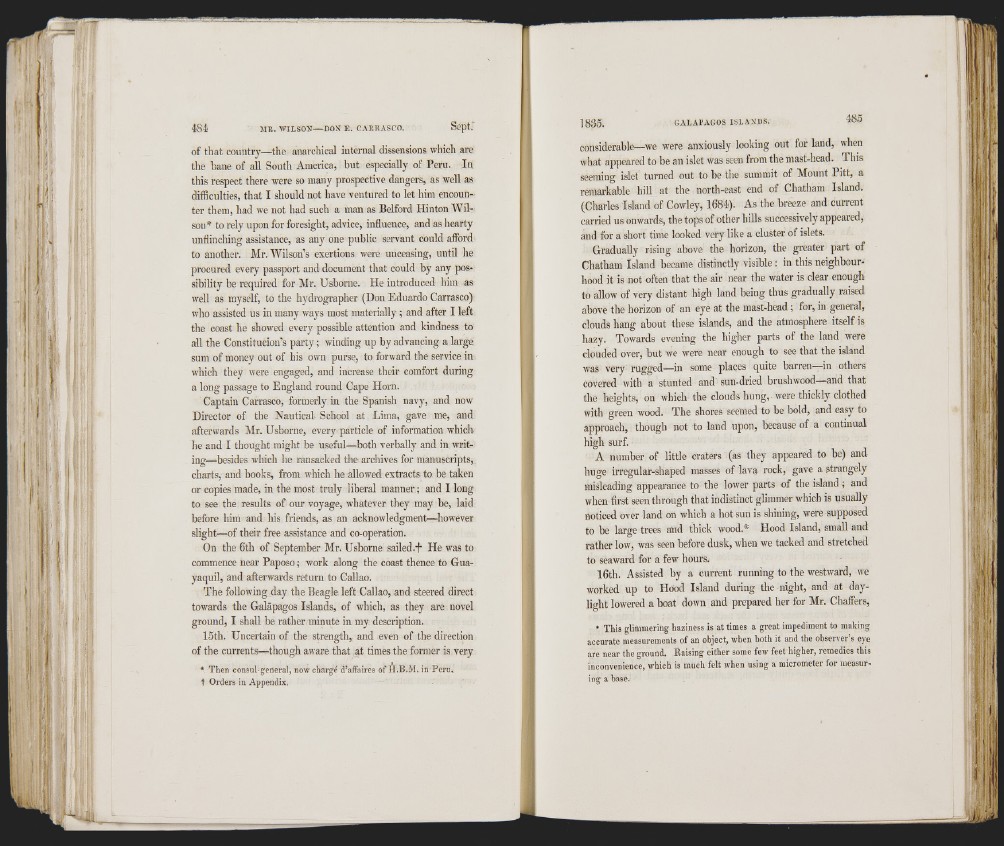
N
L i
M:
I .i
. .,L
of that country—the anarchical internal dissensions which are
the bane of all South America, but especially of Peru. In
this respect there were so many prospective dangers, as well as
difficulties, that I should not have ventured to let him encounter
them, had we not had such a man as Belford Hinton Wilson*
to rely upon for foresight, advice, influence, and as hearty
unflinching assistance, as any one public servant could afford
to another. Mr. Wilson’s exertions were unceasing, until he
procured every passport and document that could by any possibility
be required for Mr. Usborne. He introduced him as
well as myself, to the hydrographer (Don Eduardo Carrasco)
who assisted us in many ways most materially ; and after I left
the coast he showed every possible attention and kindness to
all the Constitucion’s party ; winding up by advancing a large
sum of money out of his own purse, to forward the service in
which they were engaged, and increase their comfort during
a long passage to England round Cape Horn.
Captain Carrasco, formerly in the Spanish navy, and now
Director of the Nautical School at Lima, gave me, and
afterwards Mr. Usborne, every particle of information which
he and I thought might be useful—both verbally and in writing—
besides which he ransacked the archives for manuscripts,
charts, and books, from which he allowed extracts to be taken
or copies made, in the most truly liberal manner ; and I long
to see the results of our voyage, whatever they may be, laid
before him and his friends, as an acknowledgment—however
slight—of their free assistance and co-operation.
On the 6th of September Mr. Usborne sailed.# He was to
commence near Paposo ; work along the coast thence to Guayaquil,
and afterwards return to Callao.
The following day the Beagle left Callao, and steered direct
towards the Galapagos Islands, of which, as they are novel
ground, I shall be rather minute in my description.
15th. Uncertain of the strength, and even of the direction
of the currents—though aware that at times the former is very
* Then consul-general, now charge d’affaires of H.B.M. in Peru.
t Orders in Appendix,
considerable—we were anxiously looking out for land, when
what appeared to be an islet was seen from the mast-head. This
seeming islet turned out to be the summit of Mount Pitt, a
remarkable hill at the north-east end of Chatham Island.
(Charles Island of Cowley, 1684). As the breeze and current
carried us onwards, the tops of other hills successively appeared,
and for a short time looked very like a cluster of islets.
Gradually rising above the horizon, the greater part of
Chatham Island became distinctly visible : in this neighbourhood
it is not often that the air near the water is clear enough
to allow of very distant high land being thus gradually raised
above the horizon of an eye at the mast-head ; for, in general,
clouds hang about these islands, and the atmosphere itself is
hazy. Towards evening the higher parts of the land were
clouded over, but we were near enough to see that the island
was very rugged—in some places quite barren—in others
covered with a stunted and sun-dried brushwood—and that
the heights, on which the clouds hung, were thickly clothed
with green wood. The shores seemed to be bold, and easy to
approach, though not to land upon, because of a continual
high surf.
A number of little craters (as they appeared to be) and
huge irregular-shaped masses of lava rock, gave a strangely
mirieading appearance to the lower parts of the island ; and
when first seen through that indistinct glimmer which is usually
noticed over land on which a hot sun is shining, were supposed
to be large trees and thick wood.* Hood Island, small and
rather low, was seen before dusk, when we tacked and stretched
to seaward for a few hours.
16th. Assisted by a current running to the westward, we
worked up to Hood Island during the night, and at daylight
lowered a boat down and prepared her for Mr. Chaffers,
• This glimmering haziness is at times a great impediment to making
accurate measurements of an object, when both it and the observer’s eye
are near the ground. Raising either some few feet higher, remedies this
inconvenience, which is much felt when using a micrometer for measur-
ing a base.